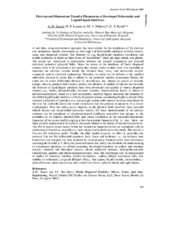Приказ основних података о документу
Electron and momentum transfer phenomena at developed deformable and rigid liquid-liquid interfaces
| dc.creator | Spasić, Aleksandar | |
| dc.creator | Lazarević, Mihailo | |
| dc.creator | Mitrović, Milan | |
| dc.creator | Krstić, Dimitrije | |
| dc.date.accessioned | 2023-03-07T19:22:10Z | |
| dc.date.available | 2023-03-07T19:22:10Z | |
| dc.date.issued | 2005 | |
| dc.identifier.isbn | 86-905111-0-5 | |
| dc.identifier.uri | https://machinery.mas.bg.ac.rs/handle/123456789/5456 | |
| dc.description.abstract | A new idea, using deterministic approach, has been applied for the elucidation of the electron and momentum transfer phenomena at, both rigid and deformable interfaces in finely (micro, nano, atto) dispersed systems. The behavior of e.g., liquid/liquid interfaces (emulsions and double emulsions) is based on three forms of “instabilities”; these are rigid, elastic, and plastic. The events are understood as interactions between the internal (immanent) and external (incident) periodical physical fields. Since the events at the interfaces of finely dispersed systems have to be considered at the molecular, atomic, and/or entities level it is inevitable to introduce the electron transfer beside the classical heat, mass, and momentum transfer commonly used in chemical engineering. Therefore, an entity can be defined as the smallest indivisible element of matter that is related to the particular transfer phenomena. Hence, the entity can be either differential element of mass/demon, ion, phonon as quanta of acoustic energy, infon as quanta of information, photon, and electron. A number of theories that describe the behavior of liquid/liquid interfaces have been developed and applied to various dispersed systems e.g., Stokes, Reiner-Rivelin, Ericksen, Einstein, Smoluchowski, Kinch. A theory of electroviscoelasticity, based on a new constitutive model of liquids describes the behavior of electrified liquid/liquid interfaces in finely dispersed systems considering droplet or droplet-film structure (collective of particles) as a macroscopic system with internal structure determined by the way the molecules (ions) are tuned (structured) into the primary components of a cluster configuration. How the tuning occurs depends on the physical fields involved, both potential (elastic forces) and nonpotential (resistance forces). All these microelements of the primary structure can be considered as electromechanical oscillators assembled into groups, so the excitation by an external physical field may cause oscillations at the resonant/characteristic frequency of the system itself (coupling at the characteristic frequency). Up to day, there are three possible mathematical formalisms discussed related to the theory of electroviscoelasticity. The first is tension tensor model, where the normal and tangential forces are considered, only in mathematical formalism, regardless to their origin (mechanical and/or electrical). The second is Van der Pol derivative model. Finally, the third model comprise an effort to generalize the previous Van der Pol differential equations, both, linear and nonlinear; i.e., the ordinary time derivatives and integrals are now replaced by corresponding fractional-order time derivatives and integrals of order p<1. Both, the presented model and theory can facilitate the understanding of entrainment problems in solvent extraction, developed interfaces in colloid and interface science, chemical and biological sensors, electro analytical methods, biology/biomedicine (hematology, genetics and electroneurophysiology). Also, this knowledge may be implemented in studies of structure; interface barriers/symmetries, -surface (bilipid membrane cells, free bubbles of surfactants, Langmuir Blodgett films), -line (genes, liquid crystals, microtubules), - point (fulerenes, micro-emulsions), and -overall (dry foams, polymer elastic and rigid foams). | sr |
| dc.language.iso | en | sr |
| dc.publisher | Belgrade: Department of Graphical Engineering, Faculty of Technology and Metallurgy | sr |
| dc.publisher | Belgrade: Association of Chemical Engineers | sr |
| dc.rights | openAccess | sr |
| dc.rights.uri | https://creativecommons.org/share-your-work/public-domain/cc0/ | |
| dc.source | Book of Abstract of 1st South East European Congress of Chemical Engineering – SEECChE 1, Belgrade, September 25-28, 2005 | sr |
| dc.subject | liquid/liquid interfaces | sr |
| dc.subject | momentum transfer phenomena | sr |
| dc.subject | electron transfer phenomena | sr |
| dc.subject | fractional order | sr |
| dc.title | Electron and momentum transfer phenomena at developed deformable and rigid liquid-liquid interfaces | sr |
| dc.type | conferenceObject | sr |
| dc.rights.license | CC0 | sr |
| dc.citation.epage | 125 | |
| dc.citation.spage | 125 | |
| dc.identifier.fulltext | http://machinery.mas.bg.ac.rs/bitstream/id/13393/SpasicLazarevicSEE1Che2005.pdf | |
| dc.identifier.rcub | https://hdl.handle.net/21.15107/rcub_machinery_5456 | |
| dc.type.version | publishedVersion | sr |


